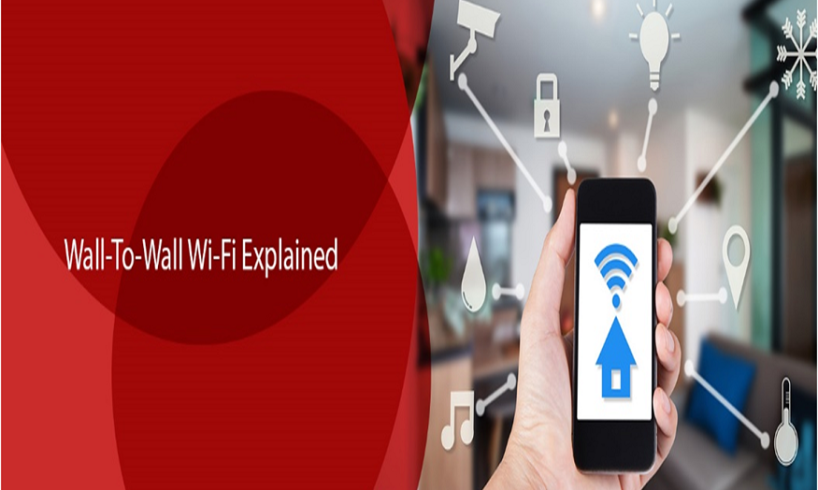
Wi-Fi has become the predominant way of connecting to the internet. We’re increasingly replacing bulky computers with mobile devices such as smartphones, tablets, and ultra-slim laptops that don’t have Ethernet ports. Wi-Fi technology has also matched the speed and latency of wired systems with Wi-Fi 6.
However, there’s still one problem with Wi-Fi systems: their limited range. Wi-Fi uses high-frequency electromagnetic waves in 2.6, 5, and 6 GHz bands to transfer data. Higher frequencies can transmit data faster, but they also have a lower range compared to lower frequencies used by cellular networks. This makes Wi-Fi connections fast and reliable at close range but slow and laggy at longer distances.
Wall-to-Wall Wi-Fi is a group of technologies aimed to solve problems. These technologies increase the range of Wi-Fi, allowing signals to reach the entire house without leaving any dead spots.
Three common types of devices can do this. We recommend getting eero Mesh WiFi with internet from Grande Communications for the best wall-to-wall Wi-Fi experience. Here’s how these technologies work.
Types of Wall-to-Wall Wi-Fi Systems
Wi-Fi Extenders
Wi-Fi routers use electromagnetic waves to transmit data. Just like light, the intensity of these waves is inversely proportional to the square of the distance. In other words, if you double the distance between you and your router, the signal gets four times weaker. This is called the inverse square law of electromagnetic radiation.
Electromagnetic waves also have trouble traveling through walls and they lose intensity exponentially passing through dense materials. Both of these factors lower the signal strength significantly as it travels from the router in the living room to your device in your bedroom.
Wi-Fi extenders are meant to increase the overall strength of the signal. They have more sensitive receivers than smart devices and more powerful transmitters than Wi-Fi routers. They listen to the Wi-Fi router and repeat the signal louder for smart devices.
If you place your router in the living room and an extender in the bedroom upstairs, you’ll have much stronger signals in all the rooms close to the extender.
However, extenders add an extra step between you and your router. They can lower your internet speed by 50%. You also have to manually switch between the router and the extender from your device or it’ll stay connected to the extender even when you’re closer to the router.
Long-Range Wi-Fi Routers
If signals are weak, why not get Wi-Fi routers with more power? Long-range Wi-Fi routers transmit stronger signals that remain strong enough even at long distances. But this solution is far from perfect.
Long-range Wi-Fi routers consume a lot of power. The inverse square law applies to long-range Wi-Fi routers just as it does to any other router. To double the range of a router, they need roughly four times more power; to triple it, nine times more power; and so on.Long-range Wi-Fi routers can also have blind spots behind materials that don’t allow Wi-Fi signals to pass through.
Mesh Wi-Fi Networks
We’re all aware of the inverse square law in our daily life. It’s why we use multiple light sources in a room to light it evenly. A single larger light source at the center of the room will make some parts too bright while others too dark. It’ll also cast more prominent shadows.
This is the perfect analogy for the difference between Wi-Fi routers and mesh Wi-Fi networks. Mesh Wi-Fi networks use multiple Wi-Fi devices to provide a connection at different parts of the home. If a long-range Wi-Fi router is a large single light source, a mesh Wi-Fi network is a group of smaller light sources that give more even light everywhere.
Mesh Wi-Fi networks use less power than long-range routers to give strong signals everywhere in the house. They also leave fewer blind spots—areas unreachable by one router may be in the range of another.
Mesh Wi-Fi Networks vs. Wi-Fi Extenders
Mesh Wi-Fi networks may sound similar to Wi-Fi extenders, but the two technologies are worlds apart. A Wi-Fi extender acts as an intermediary between your device and your Wi-Fi by creating a new copy of the network. On the other hand, mesh Wi-Fi is a single network.
Each device in a mesh Wi-Fi network can act as a router and communicate directly with your device without adding delay. Your device also switches to the nearest router automatically as you walk around the house, so you’re always connected to the one giving off the strongest signals.
Eero Wi-Fi takes it one step further with patented TrueMesh technology which reduces drop-offs and dead spots. Eero also uses Wi-Fi 6E, the successor of Wi-Fi 6, to deliver the fastest speed your ISP allows.
Grande Internet With eero Wi-Fi
Grande Internet is powered by a fiber-rich network to deliver broad bandwidth internet in Texas. You can get eero Wi-Fi with Grande Internet and enjoy high-speed internet with low anywhere in the house. Visit buytvinternetphone.com to check for availability.
